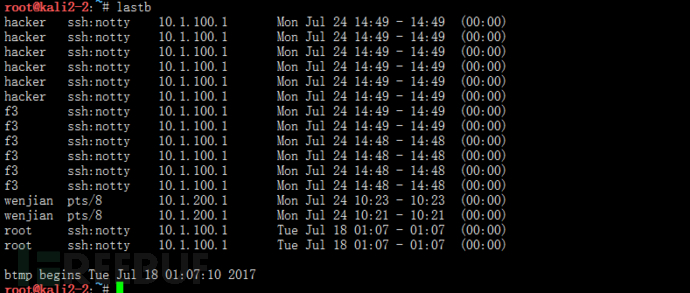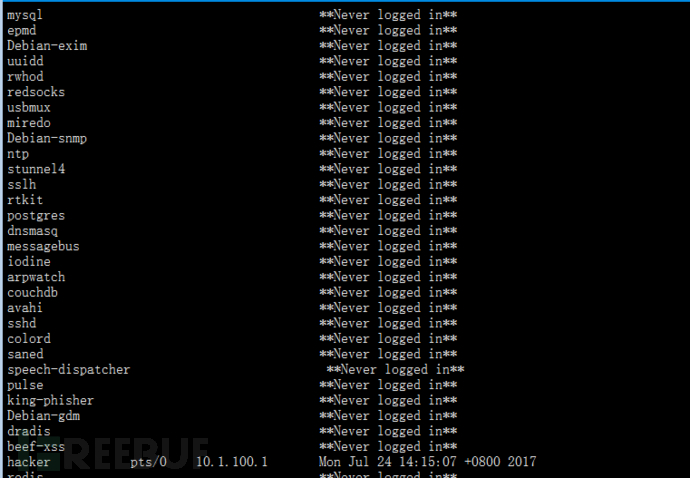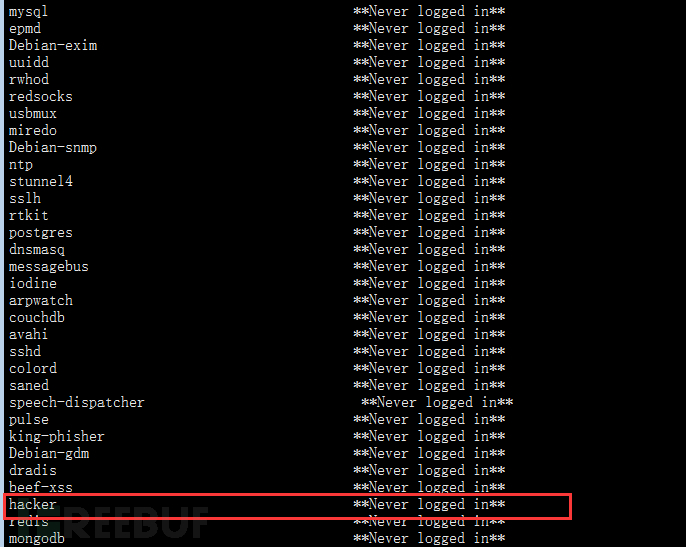渗透测试TIPS之删除、伪造Linux系统登录日志
作者:admin | 时间:2017-8-1 02:22:40 | 分类:黑客技术 隐藏侧边栏展开侧边栏
0×00. 引言
擦除日志在渗透测试中是非常重要的一个阶段,这样可以更好地隐藏入侵痕迹,做到不被系统管理人员察觉,实现长期潜伏的目的。 前段时间NSA泄露的渗透测试工具中就有一款wtmp日志的擦除,非常好用,这引起了我的兴趣,于是研究了一下linux 登录相关二进制日志的文件格式,用python写了一个日志擦除,伪造的工具(末尾附源码)
0×01. Linux中与登录有关的日志及其格式分析
Linux中涉及到登录的二进制日志文件有
/var/run/utmp
/var/log/wtmp
/var/log/btmp
/var/log/lastlog 其中 utmp 对应w 和 who命令; wtmp 对应last命令;btmp对应lastb命令;lastlog 对应lastlog命令
经查Linux man 手册,
/var/run/utmp
/var/log/wtmp
/var/log/btmp 的二进制格式都是一样的, 我们姑且称之为xtmp 格式
而/var/log/lastlog 文件的格式与之不同,需单独分析,下面我们先分析xtmp的文件格式吧,这里以utmp 格式为例
UTMP 文件格式
utmp 文件格式是这样的:
#define UT_LINESIZE 32 #define UT_NAMESIZE 32 #define UT_HOSTSIZE 256 struct utmp { short ut_type; /* Type of record */ pid_t ut_pid; /* PID of login process */ char ut_line[UT_LINESIZE]; /* Device name of tty - "/dev/" */ char ut_id[4]; /* Terminal name suffix,
or inittab(5) ID */ char ut_user[UT_NAMESIZE]; /* Username */ char ut_host[UT_HOSTSIZE]; /* Hostname for remote login, or
kernel version for run-level
messages */ struct exit_status ut_exit; /* Exit status of a process
marked as DEAD_PROCESS; not
used by Linux init(8) */ /* The ut_session and ut_tv fields must be the same size when
compiled 32- and 64-bit. This allows data files and shared
memory to be shared between 32- and 64-bit applications. */ #if __WORDSIZE == 64 && defined __WORDSIZE_COMPAT32 int32_t ut_session; /* Session ID (getsid(2)),
used for windowing */ struct { int32_t tv_sec; /* Seconds */ int32_t tv_usec; /* Microseconds */ } ut_tv; /* Time entry was made */ #else long ut_session; /* Session ID */ struct timeval ut_tv; /* Time entry was made */ #endif int32_t ut_addr_v6[4]; /* Internet address of remote
host; IPv4 address uses
just ut_addr_v6[0] */ char __unused[20]; /* Reserved for future use */ };
其中 exit_status 结构为: struct exit_status { /* Type for ut_exit, below */ short int e_termination; /* Process termination status */ short int e_exit; /* Process exit status */ };
其中 ut_type 为日志记录的类型,主要有以下几种日志 #define EMPTY 0 /* Record does not contain valid info
(formerly known as UT_UNKNOWN on Linux) */ #define RUN_LVL 1 /* Change in system run-level (see
init(8)) */ #define BOOT_TIME 2 /* Time of system boot (in ut_tv) */ #define NEW_TIME 3 /* Time after system clock change
(in ut_tv) */ #define OLD_TIME 4 /* Time before system clock change
(in ut_tv) */ #define INIT_PROCESS 5 /* Process spawned by init(8) */ #define LOGIN_PROCESS 6 /* Session leader process for user login */ #define USER_PROCESS 7 /* Normal process */ #define DEAD_PROCESS 8 /* Terminated process */ #define ACCOUNTING 9 /* Not implemented */ #define UT_LINESIZE 32 #define UT_NAMESIZE 32 #define UT_HOSTSIZE 256 utmp 记录例子(二进制内容解析处理后):

对比utmp的文件格式结构,挑几个重要的字段解释下
第1个字段7 表示这条记录类型,一般的用户正常登录记录类型都是7,错误登录是6 ,也就是btmp所记录的类型
第2个字段1497 是pid ,截图中我是用ssh远程登录linux,这里指的就是sshd的子进程bash的pid

第3个字段pts/0 表示的登录的伪终端 ,后面一串\0是填充的数据
第4个字段 ts/0表示的伪终端的后缀
第5个字段root 表示登录用户名,后面一串\0是填充数据,因为这个字段为32个字节大小
第6个字段10.1.100.1 表示的是登录主机,后面一串\0是填充数据,因为这个字段为256个字节大小
第10个字段表示的是登录时间,精确到秒
第11个字段表示的是登录时间中微妙部分
第12个字段表示的是登录sessionid
lastlog 文件格式:
#define UT_LINESIZE 32 #define UT_HOSTSIZE 256 struct lastlog
{ __time_t ll_time; char ll_line[UT_LINESIZE]; char ll_host[UT_HOSTSIZE];
}; lastlog 记录例子(二进制内容解析处理后):
第1个字段表示最后一次登录时间
第2个字段表示最后一次登录的终端
第3个字段表示最后一次登录的IP
0×02. 擦除,伪造登录日志的测试
1.删除utmp记录,将自己从w或者who输出中隐藏
比如此时有两个登录记录,一个是root(要删除的记录),一个是f3
删除前:
删除后:
- 添加utmp记录,伪造登录信息
添加前:
添加后:
注: 添加Fake 在线记录的时候,pid必须可以找到相应进程,一般可以使用sshd的或者是bash的相关PID
2.删除历史登录记录(wtmp)
删除前:
删除指定用户,指定host的历史登录记录
删除后:
3.添加wtmp记录
4.删除btmp记录
删除前
hacker 这个账户有很多次尝试登录记录
删除后:
5.添加btmp 伪造记录
6.删除lastlog 记录
hacker 用户最后一次登录记录,删除前:
删除后:
7.添加伪造的lastlog记录
python fake_login_log.py –mode add –type=lastlog –user=hacker –date=”2017-7-24 14:22:07
这里说明一下:lastlog中并不记录用户名,而是根据文件偏移位置来计算当前记录的用户名是多少,比如当前用户是f3,其UID为1001,那么lastlog 日志从头开始向后移动 1001 × LAST_STRUCT_SIZE处的位置则为f3用户最后一次登录记录写入处(用户即使没有最后一次登录记录,在相应的偏移处都会有记录,这就是我们使用lastlog看到的never login的记录)
0×03. 源码
直接帖源码,格式上可能会影响阅读体验,帖下我的在线源码地址吧:点击打开在线源码
0×04. 总结
目前此工具可以实现对:
/var/run/utmp
/var/log/wtmp
/var/log/btmp
/var/log/lastlog 进行删除,添加伪造记录功能,并且在修改相关文件后恢复其时间属性值(比如文件访问时间和文件修改时间),有人会说了,直接echo “” >/var/log/xtmp 不就行了吗,干嘛这么麻烦,直接删除是很好,不过有点粗暴。 本工具不仅可以实现按照 登录主机,登录用户, 时间戳等条件进行按需删除,还可以添加伪造登录记录,以达到迷惑系统管理员之目的。需要补充一点的是,目前还未实现根据时间区间来删除指定记录,也希望有兴趣的同学补充一下
参考:
1)https://linux.die.net/man/5/utmp 2)https://github.com/krig/lastlog/blob/master/lastlog.c *本文作者:knpewg85942


















